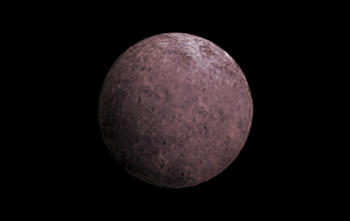Well, it still turned out to be ice also but the surprise is it may have methane slowly dissipating into space, which means it may have once had an atmosphere.
The researchers writing in Astrophysical Journal Letters say OR10 has about half its surface covered in water ice due to ancient, slush-spewing volcanoes. A few other dwarf planets at the edge of the solar system are also red. These distant dwarf planets are themselves part of a larger group of icy bodies called Kuiper Belt Objects (KBOs). As far as the researchers could tell, Snow White, though relatively large, was unremarkable, just one out of more than 400 potential dwarf planets that are among hundreds of thousands of KBOs.
Adam Burgasser, a former graduate student and now a professor at UC San Diego, was helping to design a new instrument called the Folded-port Infrared Echellette (FIRE). Last fall, they used this instrument with the 6.5-meter Magellan Baade Telescope in Chile to take a closer look at 2007 OR10. As expected, Snow White was red but the spectrum revealed that the surface was covered in water ice. "That was a big shock," says Mike Brown, the Richard and Barbara Rosenberg Professor and professor of planetary astronomy at Caltech. "Water ice is not red."

An artist's conception of 2007 OR10, nicknamed Snow White. Astronomers suspect that its rosy color is due to the presence of irradiated methane. Credit: NASA
Although ice is common in the outer solar system, it's almost always white, but there is one other dwarf planet that's both red and covered with water ice: Quaoar, which Brown helped discover in 2002. Slightly smaller than Snow White, Quaoar is still big enough to have had an atmosphere and a surface covered with volcanoes that spewed an icy slush, which then froze solid as it flowed over the surface.
But because Quaoar isn't as big as a dwarf planet like Eris or the recently-demoted Pluto, it could not hold onto volatile compounds like methane, carbon monoxide, or nitrogen as long. A couple of billion years after Quaoar formed, it began to lose its atmosphere to space; now, all that remains is some methane. Over time, exposure to the radiation from space turned that methane—which consists of a carbon atom bonded to four hydrogen atoms—into long hydrocarbon chains, which look red. Like the frost that covers a lawn on a cold morning, the irradiated methane sits on Quaoar's icy surface, giving it a rosy hue.
The spectrum of 2007 OR10 looks similar to Quaoar's, suggesting that what happened on Quaoar also happened on 2007 OR10. "That combination—red and water—says to me, 'methane,'" Brown explains. "We're basically looking at the last gasp of Snow White. For four and a half billion years, Snow White has been sitting out there, slowly losing its atmosphere, and now there's just a little bit left."
Although Snow White's spectrum clearly shows the presence of water ice, Brown says, the evidence for methane is not yet definitive. To find out, the astronomers will have to use a big telescope like the one at the Keck Observatory. If it turns out that Snow White does indeed have methane, it will join Quaoar as one of only two dwarf planets that straddle the border between the handful of objects large enough to hold onto volatile compounds, and the smaller bodies that make up the vast majority of KBOs.
What about that name? "Snow White" was just a nickname he and his colleagues used, it was designated such by Brown's former graduate student Meg Schwamb, the discoverer. It no longer makes sense for describing a very red object but it mattered little until now - before the discovery of water ice and the possibility of methane.
Maybe a contest?




Comments